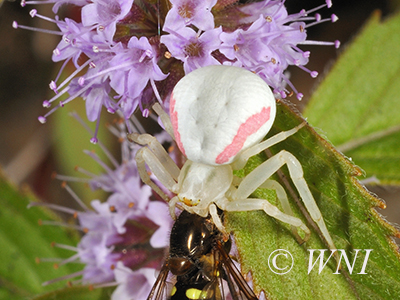| Typical Crab Spiders (Thomisidae) |
The Thomisidae include 7 subfamilies, ca. 175 genera, and over 2,100 species, and occur nearly worldwide. These are small to medium-sized spiders (2-23 mm) with broad, moderately flattened carapace and abdomen. The first two pair of legs is longer than the rest. The Thomisidae move in a crab-like manner, i.e., walking sideways, forwards, and backwards. The chelicerae (jaws) are relatively small and weak, but the venom is very potent, killing insect prey within seconds. Sexual dimorphism, in color and size, is common in this family and can be extreme; the males are much smaller and darker than the females. Diurnal species are often brightly coloured, and some are able to change colour to match the surroundings; others are drab, patterned with grey or brown. The Thomisidae are ambush predators, and use their elongated front legs to grab and hold on to prey, often much larger than themselves, while delivering a bite. Some species prey on pollinators on flowers, others hunt under loose bark, in crevices, and the leaf litter.
 |
Goldenrod Crab Spider (Misumena vatia) |
|
| Unauthorized use of our images is NOT permitted. | ||
| Hotlinking or "pinning" of our images to websites is STRICTLY PROHIBITED. | ||
| Copyright © Michael Patrikeev - All Rights Reserved | ||
| |
||





